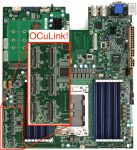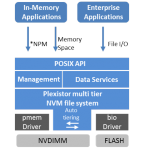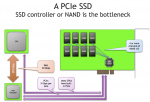With the advent of AMD Threadripper and Epyc, we are about to see an explosion of PCIe lanes in the pro-sumer and datacenter market. Although many of those lanes will be taken up by conventional PCIe cards, some will be used for SSD’s (M.2 and U.2) or for external connectivity. This is where OCuLink might finally take off: As an AMD alternative to Thunderbolt for external PCIe peripheral connectivity.
NVMe
My Core i7 Macintosh SE
I recently built the biggest, clunkiest iPad mini case ever, transforming my old Macintosh SE case into an iPad stand. But what to do with that empty case? Why, it’s the perfect size for a custom Mini-ITX PC! Introducing my liquid-cooled Core i7 monster Mac SE!
Plexistor Integrates NVDIMM for Every Application
I’m really excited about the prospects of memory-addressable flash. Moving flash closer to the CPU and addressing it as memory rather than block storage brings tremendous performance benefits, and is a once-in-a-generation radical change to system architecture. But questions remain as to how it can be integrated with today’s applications. Now Plexistor is here with a promising solution: Their “Software-Defined Memory” concept is a generic filesystem for storage, from NVDIMM to NVMe to SSD.
Apple Packs PCIe SSD Alongside PC-Fast CPU and Graphics in iPhone 6s and iPad Pro
We all knew that the iPhone 6s and iPad pro would boast CPU and graphics performance to challenge mainstream PC’s, but it has now been revealed that the storage layer packs revolutionary NVMe/PCIe connectivity and performance. Although the iPhone 6s doesn’t need this kind of performance, the forthcoming iPad Pro ought to rock!
Why Are PCIe SSDs So Fast?
The world of storage can be confusing, with obscure terms hiding massive differences in technology and performance. Such is the case for the latest PCI express SSDs: They are much faster than traditional SAS or SATA SSDs, but many aren’t sure exactly why. In this article, I will try to explain the real difference.




